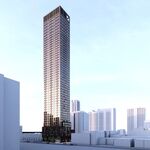north-of-anything
Active Member
Here's my visualization of approximately where the west extension could go.

Not all these stations are necessary, but I think the most important stations would be Palmerston, Roncesvalles (as a transit hub of some kind), Humber Bay (as a transfer point for streetcar riders from the west), East Mall, and Dixie (to potentially reduce the amount of Mississauga residents getting on Kipling).
The extension could potentially be elevated from Etobicoke Creek to east of Parkside, as Queensway definitely has the space for it.
Considering the existing plans to improve the Waterfront West lines, as well as the most likely scenario that the TTC will cheap out and use Toronto gauge for the relief line, I think this is one of the best-case scenarios. (Plus, bringing the subway into Peel might help win over some big-name and big-wallet supporters.)
Not all these stations are necessary, but I think the most important stations would be Palmerston, Roncesvalles (as a transit hub of some kind), Humber Bay (as a transfer point for streetcar riders from the west), East Mall, and Dixie (to potentially reduce the amount of Mississauga residents getting on Kipling).
The extension could potentially be elevated from Etobicoke Creek to east of Parkside, as Queensway definitely has the space for it.
Considering the existing plans to improve the Waterfront West lines, as well as the most likely scenario that the TTC will cheap out and use Toronto gauge for the relief line, I think this is one of the best-case scenarios. (Plus, bringing the subway into Peel might help win over some big-name and big-wallet supporters.)




